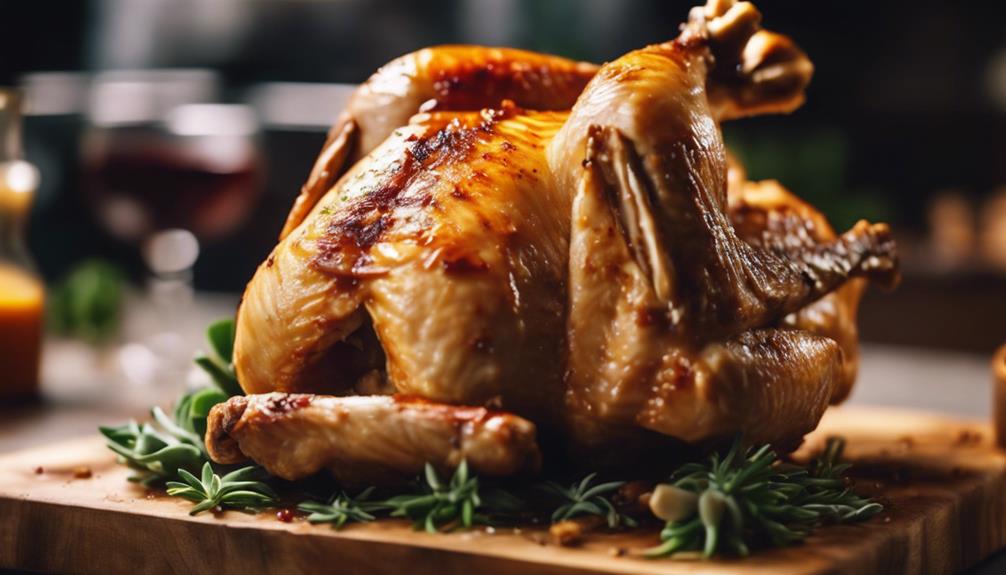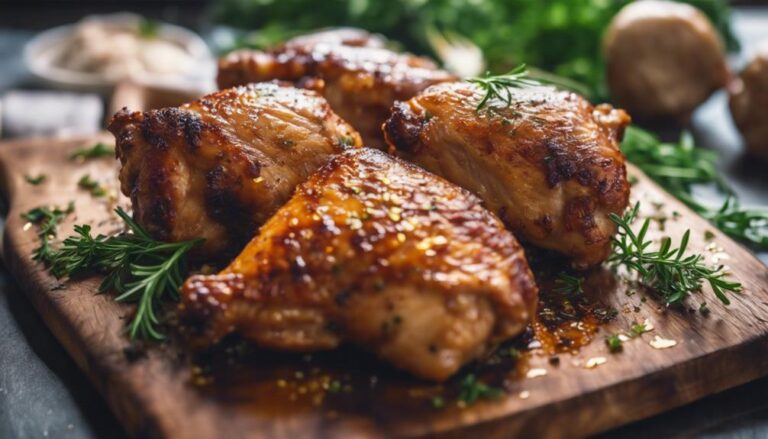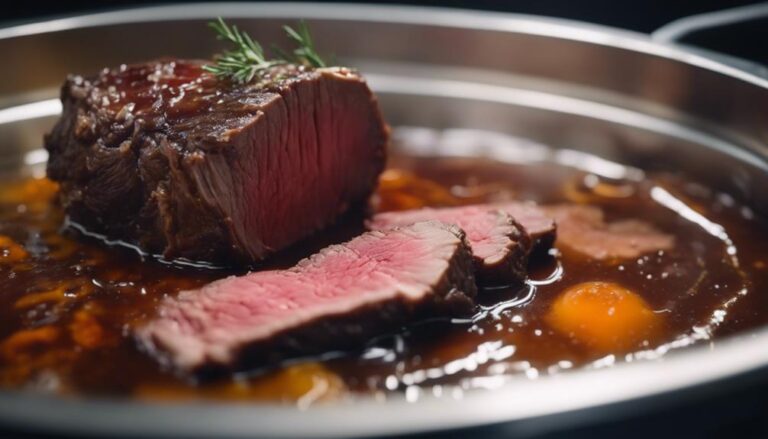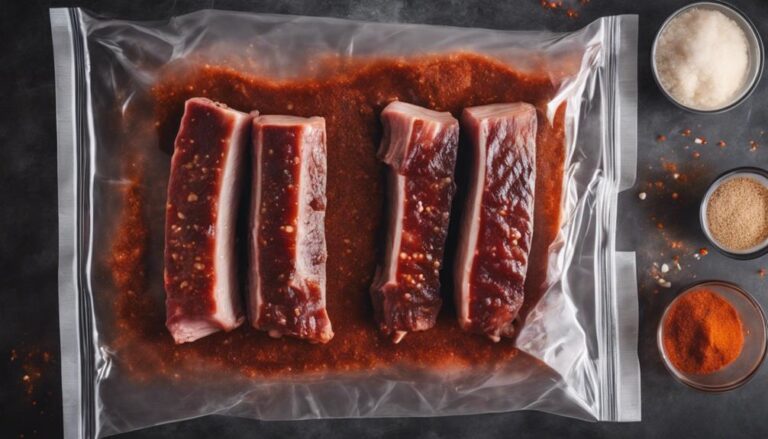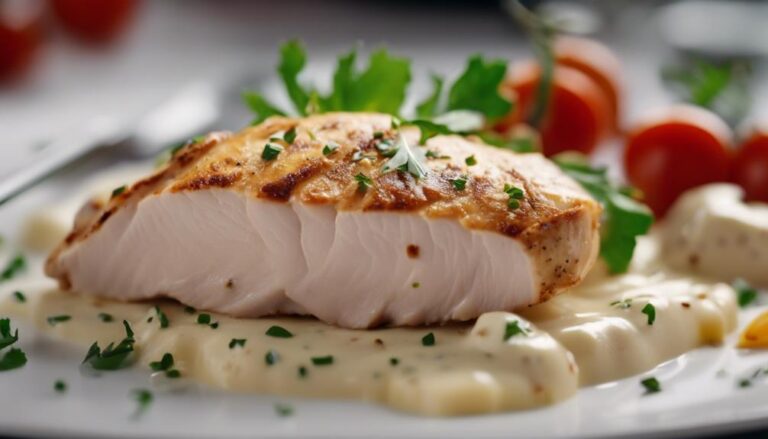Sous Vide Whole Chicken: Juicy Every Time
Achieve juicy perfection every time with sous vide cooking for a whole chicken. Seal in moisture and flavor, ensuring a succulent and delightful meal. Sous vide, originally from France, involves precise temperature control, guaranteeing tender results. Using a vacuum-sealed bag is key to this method. Enjoy a juicy chicken by evenly cooking and pasteurizing with this technique. The secret lies in the perfect balance of time and temperature.
What You Will Learn Here
- Sous vide whole chicken retains moisture for a juicy result.
- Precise temperature control ensures optimal cooking.
- Vacuum-sealing enhances flavor infusion and tenderness.
- Spatchcocking promotes even cooking and faster pasteurization.
- Consistent, reliable outcomes with sous vide method.
Sous Vide Origins
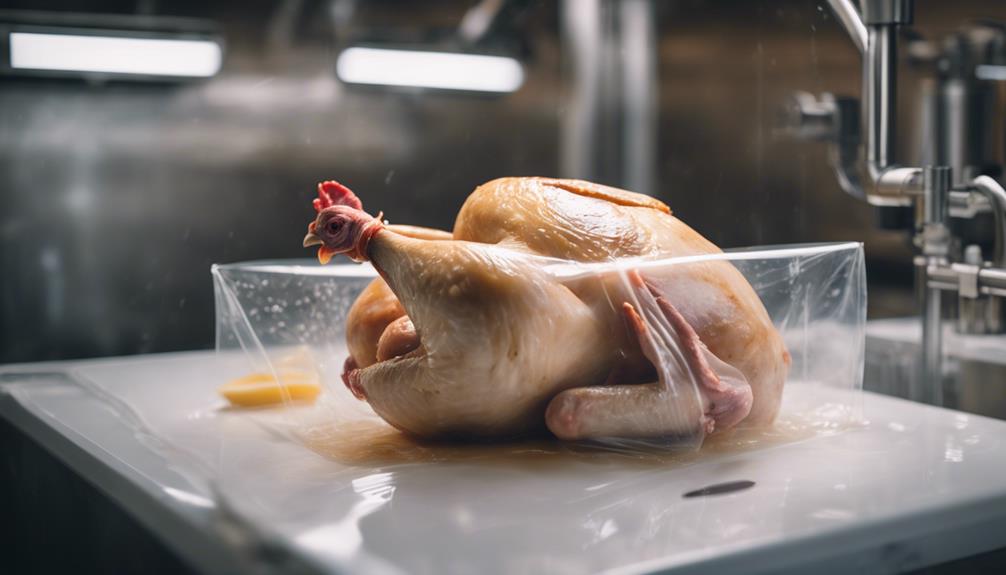
Sous vide cooking, originating in France in the 1970s, revolutionized culinary techniques with its focus on maintaining food integrity.
The term 'sous vide' itself, meaning 'under vacuum,' underscores the method's emphasis on precise cooking conditions.
This cooking technique's evolution from professional kitchens to home use highlights its adaptability and appeal to a wide range of cooks.
Sous Vide History
Originating in France during the 1970s, the sous vide cooking technique revolutionized the culinary world with its precise temperature control and innovative approach to food preparation. Chef Georges Pralus played a pivotal role in its development, using sous vide to perfect the cooking of foie gras.
The term 'sous vide' itself translates to 'under vacuum' in French, alluding to the vacuum-sealed bags integral to the process. Initially embraced by professional kitchens for its ability to deliver consistent results and high-quality dishes, sous vide has now found its way into home kitchens worldwide.
This method's evolution from a professional culinary secret to a beloved technique for home cooks underscores its enduring appeal and versatility.
Cooking Technique Evolution
The evolution of culinary techniques saw the emergence of sous vide cooking in the 1970s, spearheaded by Chef Georges Pralus. This method, known for its precise temperature control, involves sealing food like whole chicken in a vacuum-sealed bag and cooking it in a water bath at a controlled temperature.
Sous vide cooking has revolutionized the culinary world by ensuring even cooking, ideal flavor retention, and enhanced tenderness in proteins. The use of a water bath provides a gentle heat environment that allows the chicken to cook evenly throughout without losing moisture. This precise technique results in a chicken that's tender, flavorful, and consistently cooked to perfection, making sous vide a popular choice for cooking whole chicken.
Modern Sous Vide Applications
With its roots in French culinary innovation, the technique of sous vide has transcended its origins to become a staple in modern cooking practices, especially in the domain of precise temperature control for various proteins.
Sous vide cooking involves vacuum-sealing chicken or other proteins in bags and cooking them in a water bath at controlled temperatures. This method has gained popularity for its ability to produce tender and juicy meats consistently.
Modern sous vide applications extend beyond professional kitchens to home cooks looking to achieve restaurant-quality results. By utilizing precise temperature control, sous vide guarantees that proteins are cooked to perfection, making it a favored technique among chefs and culinary enthusiasts seeking reliable and delicious outcomes.
Key Seasoning Components
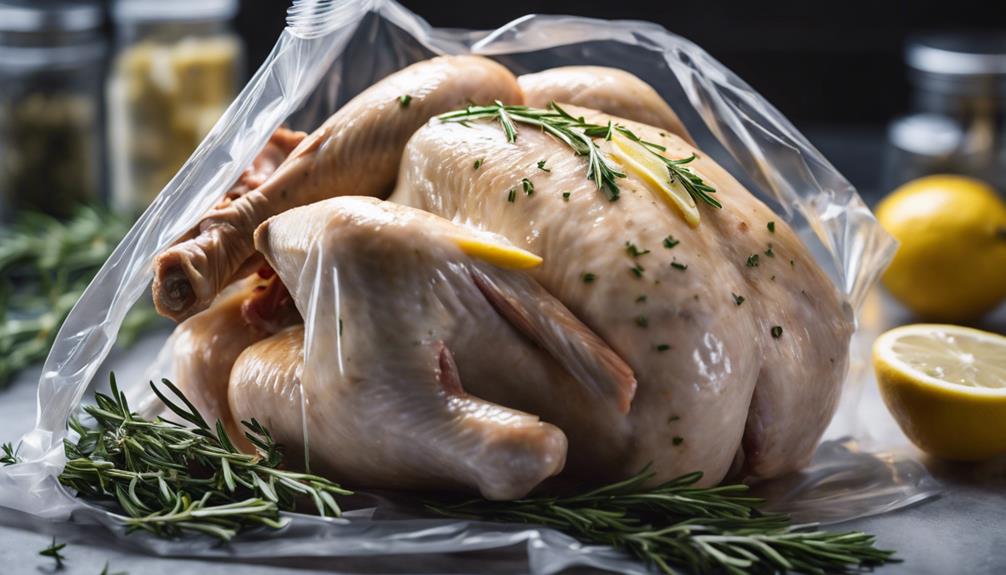
For ideal flavor infusion in sous vide whole chicken, incorporating a blend of herbs like rosemary, thyme, and sage along with salt and pepper is essential. When preparing your sous vide whole chicken, these key seasoning components play a significant role in enhancing the taste and juiciness of the final dish. Here's why they matter:
- Herbs: Rosemary, thyme, and sage add aromatic depth to the chicken, complementing its natural flavors.
- Salt: Essential for seasoning and enhancing the overall taste of the chicken.
- Pepper: Adds a subtle heat and depth to the dish, balancing the flavors of the herbs.
- Vacuum Sealing: Ensures that the chicken is fully infused with the flavors of the herbs and seasonings during the sous vide cooking process.
Customizing your seasoning components allows you to tailor the dish to your preferences, ensuring a delicious and personalized culinary experience. Remember, getting the seasoning components right is vital for creating a flavorful and juicy sous vide whole chicken.
Sous Vide Chicken Breast Recipe
When preparing sous vide chicken breast, it's essential to cook it at a precise temperature of 150°F for 1½ hours to achieve ideal tenderness.
The seasoning options for sous vide chicken breast range from dry rubs and wet sauces to simple seasonings like salt, pepper, herbs, and lemon.
Storage and reheating of sous vide chicken breast can be efficiently done in an airtight container in the refrigerator and reheated through methods such as microwave, pan-searing, baking, or air frying.
Spatchcocked Sous Vide Whole Chicken
To guarantee even cooking and best results when preparing sous vide whole chicken, consider spatchcocking the chicken by removing its backbone for consistent cooking. Here are some key points to remember:
- Spatchcocking involves removing the chicken's backbone for even cooking.
- It enables the chicken to lie flat, ensuring uniform cooking results.
- This process requires sharp kitchen shears or a sharp knife.
- Spatchcocking isn't complex and helps with precise cooking throughout.
Spatchcocked Whole Chicken Recipe
Consider spatchcocking your whole chicken when preparing sous vide chicken breasts for a evenly cooked and flavorful outcome. Spatchcocking involves removing the backbone of the chicken to guarantee even cooking and tenderness.
To start, season your chicken breasts generously and vacuum seal them for peak flavor infusion during sous vide cooking. Set your sous vide machine to 150°F and cook the chicken breasts for 1½ hours to achieve perfect tenderness.
After cooking, allow the chicken breasts to rest before optionally searing them for a crispy crust. Serve these succulent sous vide chicken breasts with your favorite sides or incorporate them into meal prep for easy and delicious meals.
Spatchcocked Chicken Sous Vide
Spatchcocking your whole chicken for sous vide cooking guarantees consistent cooking and enhances the tenderness and flavor of the chicken breasts.
- Spatchcocking: Removing the backbone ensures even cooking.
- Lie Flat: Chicken lays flat during sous vide, yielding consistent results.
- Pasteurization: Spatchcocking aids in uniform cooking and pasteurization.
- Sharp Tools: Sharp kitchen shears or a knife are essential for best results.
Spatchcocking the chicken before sous vide cooking is a simple yet effective technique that results in juicy and flavorful meat every time. By allowing the chicken to lay flat and ensuring even cooking, this method enhances the overall cooking process. Make sure to use sharp tools for a clean cut and optimal results when spatchcocking your chicken for sous vide preparation.
Spatchcocking Technique Benefits
Spatchcocking your chicken provides several advantages.
By eliminating the backbone, you guarantee even cooking throughout the bird.
This technique also decreases cooking time and helps achieve a crispy skin finish.
Spatchcocking for Even Cooking
When preparing a whole chicken for sous vide cooking, the removal of the backbone is an important step that greatly enhances the cooking process. Spatchcocking, which involves removing the backbone, allows the chicken to lie flat, ensuring uniform heat distribution during sous vide cooking. By spatchcocking the chicken, you enable it to cook more quickly and efficiently. This technique plays a critical role in ensuring that the chicken cooks through evenly, reducing the risk of undercooked or overcooked areas.
Additionally, removing the backbone aids in pasteurization, contributing to meeting food safety standards. Embracing spatchcocking for even cooking isn't just about enhancing flavor but also about ensuring a safe and thoroughly cooked dish for yourself and others.
Faster Cooking Time
To expedite the cooking process and guarantee even doneness, spatchcocking a whole chicken is a highly effective technique that greatly reduces cooking time. By spatchcocking the chicken, you are guaranteeing that heat distributes evenly, leading to quicker and more uniform cooking. This method allows the chicken to cook in less time while retaining its moisture content, resulting in a juicy final product. In addition, spatchcocking promotes faster pasteurization, enhancing food safety measures. In the domain of sous vide cooking, this technique proves to be especially efficient, offering a quicker cooking process overall. Embracing spatchcocking not only saves time but also ensures a delicious and safe meal for you and your guests.
| Benefits | Description |
|---|---|
| Uniform Cooking | Ensures even distribution of heat throughout the chicken for consistency |
| Moisture Retention | Helps retain the chicken's moisture, resulting in a juicy end product |
| Pasteurization | Promotes quicker pasteurization process, enhancing food safety |
| Efficient Cooking | Reduces cooking time significantly, making the process more efficient |
| Food Safety | Enhances safety measures by guaranteeing thorough cooking and pasteurization |
Crispy Skin Advantage
Enhancing the sous vide whole chicken experience, the crispy skin advantage achieved through the spatchcocking technique elevates both texture and flavor profiles. By spatchcocking the chicken, you guarantee even cooking and pasteurization as more surface area is exposed to heat, resulting in a juicy and flavorful chicken every time.
This method not only speeds up the cooking process but also allows for better seasoning penetration, enhancing the overall taste. The direct heat exposure to the skin during cooking leads to a crispy and delicious texture, adding a delightful contrast to each bite. Additionally, spatchcocking aids in creating a visually appealing presentation when serving the sous vide whole chicken, making it a feast for both the eyes and the palate.
Final Thoughts
Considering all aspects of the sous vide whole chicken recipe, it's clear that meticulous preparation and precise cooking techniques are crucial for achieving exceptional results. Sous vide cooking guarantees that the whole chicken is cooked evenly and maintains its juices, resulting in a consistently juicy texture throughout. Seasoning the chicken with herbs before vacuum sealing not only enhances its flavor but also allows for a more profound infusion of taste during the cooking process. Cooking the whole chicken at a steady 150°F for 6 hours ensures tender meat that can be used in various dishes.
To elevate the dish further, finishing the sous vide chicken in the oven or on the grill adds a delightful crispy skin, enhancing both texture and flavor profiles. This final step not only provides a visually appealing presentation but also introduces additional layers of taste to the already succulent meat. By following these steps diligently, you can create a sous vide whole chicken that isn't only juicy and flavorful but also boasts a crispy skin that will delight your taste buds and impress your guests.
Frequently Asked Questions
Does Sous Vide Keep Chicken Moist?
Sous vide keeps chicken moist by sealing in juices and maintaining precise temperature control. This technique retains natural moisture, unlike traditional methods. You can enjoy consistently juicy and succulent chicken every time with sous vide cooking.
Can You Overcook Chicken in Sous Vide?
You can overcook chicken in sous vide if the cooking time exceeds the suggested range. Proper monitoring of sous vide temperature and timing is essential to guarantee the chicken retains its desired tenderness, texture, and flavor without becoming mushy.
How Do You Keep Chicken Moist and Juicy?
To keep chicken moist and juicy, consider brining, using a meat thermometer, injecting butter, choosing flavorful seasonings, allowing a resting period, utilizing the rotisserie method, and understanding the differences between brining and marinating. Maintain proper cooking temperatures, baste, and truss effectively.
What Is the Maximum Time to Sous Vide Chicken?
The maximum recommended time to sous vide chicken is 6 hours at 150°F. This guarantees safety by pasteurizing the chicken. Cooking longer at precise temperatures ensures juiciness. Following guidelines is essential for safe, delicious results.
Conclusion
To summarize, sous vide whole chicken provides a fail-safe way to achieve juicy and flavorful results every time.
By utilizing precise temperature control and extended cooking times, this method guarantees that the chicken remains tender and moist.
With the added benefit of customizable seasonings and the option to spatchcock for even cooking, sous vide is a dependable technique for producing a delicious whole chicken dish.
Give it a try and experience the difference for yourself.
